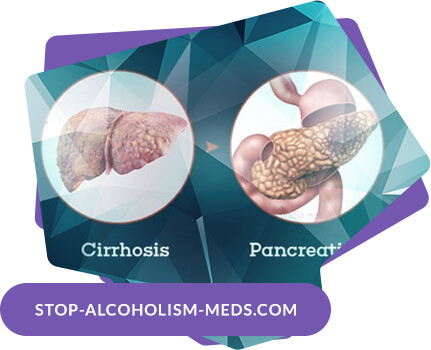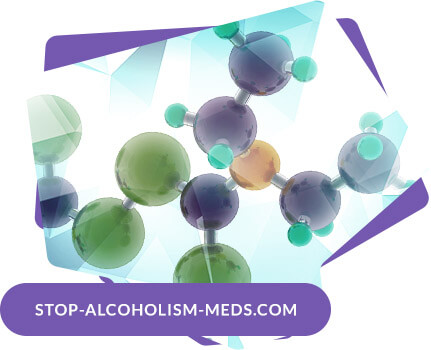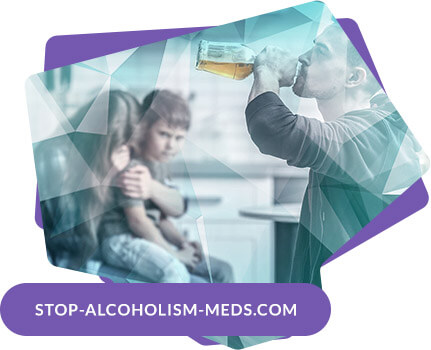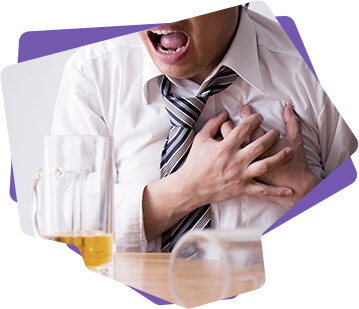The effect of alcoholization on the overall incidence of the population
Alcoholism is a disease caused by the systematic use of alcoholic beverages, characterized by a pathological attraction to them, the development of mental (irresistible attraction) and physical dependence (the appearance of withdrawal symptoms upon cessation of use). In cases of a prolonged course, the disease is accompanied by persistent mental and somatic disorders. This problem has become especially urgent for our country in the last 5-6 years, when in connection with political and economic reforms, the number of patients with this disease has increased dramatically. According to VTsIOM, every Russian, including women and children, has 180 liters of vodka drunk each year.

Etiology
The following factors play a decisive role in the formation of alcohol dependence:
- Social factors: cultural and material standard of living, stress, information overload, urbanization.
- Biological: hereditary predisposition. According to Altshuller, up to 30% of children whose parents abused alcohol can become potential alcoholics.
- Psychological: psychoemotional personality traits, the ability to socially adapt and withstand stress. In my opinion, the dominant factor in connection with which alcoholism is widespread in the Russian Federation is the low ability to social adaptation among Russians during the transition from one system to another and a sharp change in the social status of the population.
Pathogenesis
In the pathogenesis of alcoholism according to Strelchuk, there are three stages:
- Compensated,
- Drug addict,
- Terminal or decompensation stage.
Terrible signs of the onset of the disease at stage 1 are: the main symptom is an irresistible craving for alcohol, the loss of a "sense of proportion" in relation to the drunk, the formation of tolerance to alcohol and mild withdrawal symptoms. After taking high doses, amnesia occurs, and disability decreases.
At stage 1, only mental dependence is formed. Already at this time, the functioning of some organ systems is possible: alcoholic cardiomyopathies are often observed, neurasthenic symptoms are described - sleep disturbances, fatigue, causeless mood swings.
In the second stage, the painful craving for alcohol increases. This is accompanied by increasing mental changes: the concentration of all interests on alcohol, self-centeredness is an extreme form of individualism and selfishness, dulling of a sense of duty and other higher emotions, carelessness, emotional coarsening. A characteristic feature of the second stage is the final formation of withdrawal symptoms. In addition, in the second stage, the increase in alcohol tolerance, which began in the first stage, continues and reaches its maximum. According to A. Bobrov, of 1026 patients with long-term alcoholism / second stage / 78%, it was required to take at least 500 ml of vodka inside to become intoxicated. Of the somatic disorders observed: alcoholic fatty degeneration and even cirrhosis. From the gastrointestinal tract - gastritis, pancreatitis.
In the third stage, signs of mental impoverishment, somatic decrepitude and a drop in alcohol tolerance come to the fore (What we often see in homeless people). Amnesia happens even with small doses of alcohol. At the same time, both the nature of intoxication and the nature of craving for alcohol change, which from the subject of relishing turns into a means of supporting life.
General toxic effect:
- Membrane destructive action. Ethyl alcohol violates the state of the membranes, changing the structure of the bilipid layer, thereby changing their permeability, and grossly violates the transmembrane transport system.
- The pathogenic effect of the products of the metabolism of ethyl alcohol. After passing the blood-brain barrier, fusel oils and acetaldehyde enhance the release, interact with dopamine and norepinephrine, providing a psychostimulating and hallucinogenic effect.
- Change in metabolism. Fat metabolism changes - lipogenesis, cholesterol synthesis is activated. The result is atherosclerosis, fatty degeneration of the liver. The Krebs cycle is inhibited, gluconeogenesis is reduced, which contributes to hypoglycemia. Protein synthesis is blocked, resulting in hypoproteinemia.
CNS effects
Two phases of the action of alcohol on the central nervous system are distinguished:
- The phase of excitement is characterized by euphoria, a feeling of vivacity and a surge of strength, disinhibition, a decrease in self-criticism. During this phase, the metabolism of neurons of the Cortex of the Brain (CGM) is disturbed, the amount of serotonin decreases, the secretion of adrenaline, norepinephrine, dopamine, which are actively metabolized at this stage, is increased; the endogenous opioidergic system is activated: enkephalins and endorphins are released, due to the change in the person’s attitude.
- The inhibition phase, euphoria gives way to dysphoria, the reason for this is a decrease in the metabolism of norepinephrine and dopamine, the increased concentration of which causes CNS depression and depression.
Mechanisms for the development of alcohol dependence
The mechanisms for the development of alcohol dependence have not yet been fully deciphered. It was previously assumed that the formation of dependence is associated with a change in the ratios of chemicals in the brain. The decrease in the level of serotonin and morphine-like substances was seen as the main reason for the occurrence of withdrawal symptoms, which is a trigger for alcohol "self-stimulation".
However, in comparison with clinical experience, this theory was not fully confirmed: It would seem that with the introduction into practice of pharmacological preparations that normalize the content of serotonin, dopamine, endorphins, enkephalins and their receptors in the brain tissues, the problem of treating alcoholism should be solved, but like previously, the recurrence rate of the disease remains high. As it turned out recently, in addition to changes in the chemistry of the brain, there are rearrangements of its electrical activity and morphology in formations related to the limbic system. And it is precisely the combination of chemical, morphological, and electrophysical rearrangements that leads to the establishment of persistent alcohol dependence.
Reproductive effects
Alcohol undoubtedly has a detrimental effect on the testes and ovaries. At the same time, both frequent intoxication and the systematic intake of significant amounts of alcohol are equally harmful. Under the influence of alcohol abuse, fatty degeneration of the seminiferous tubules and proliferation of connective tissue in the testicular parenchyma in individuals with alcoholism are observed.
A particular manifestation of the toxic effect on the glandular tissue of the egg is beer, which penetrates the hematotesticular barrier much more easily than other alcoholic beverages, causing fatty degeneration of the glandular epithelium of the seminiferous tubules.
Along with the direct toxic effect of alcohol on the testicles, impaired liver function and its ability to destroy estrogen develop in people suffering from alcohol dependence. It is known that with cirrhosis, the amount of estrogen increases significantly in both men and women, which leads to inhibition of the pituitary gonadotropic function and subsequent atrophy of the genital glands. It should be noted that when alcohol is consumed sooner or later, depending on the individual characteristics and endurance of the body, sexual potency is also violated, which is associated with a decrease in conditioned and unconditioned reflexes, due to the inhibitory effect on subcortical centers.
In women, there are disorders of the regularity of the menstrual cycle. Due to the toxic effect on the adrenal glands, alcohol inhibits the production of androgens in them, causing sexual desire, the cost of abuse is a decrease in libido, and in advanced cases, the development of secondary frigidity is possible. When taking alcohol during pregnancy, terratogenic properties are detected, it is possible for a future child to form a genetically determined hereditary propensity for alcoholism.
It is no secret that alcohol “beats” not only the drinker himself, but also the people around him. Often men or women prone to alcoholism neglect their duties, friends, family, and children in order to satisfy their need. Addiction to alcohol is the cause of various crimes. It is known that 50 percent of all crimes are related to drinking.
Children often pay for parental alcoholism. Studies of nervous children showed that the cause of their illness is often alcoholism of parents. The fight against alcoholism is the largest social and medical problem of any state. The harm of alcohol is proven. Even small doses of it can cause great trouble or misfortune: injuries, car accidents, disability, family breakdown, loss of spiritual needs and strong-willed traits by a person.
The composition of alcohol, as you know, includes alcohol. We will analyze specifically the effect of this substance and the consequences (injuries, mortality) on humans.
Alcohols are volatile, colorless caustic liquids made up of three chemical elements: carbon, oxygen and hydrogen.
Ethyl alcohol (ethanol) is used in the production of alcoholic beverages. It can also be prescribed for medical purposes to stimulate appetite; it is also the basis in which many medicinal ingredients are dissolved.
Methyl alcohol (methanol, or “wood alcohol”) is used in industry as a fuel and solvent. It is poisonous, and its use causes blindness and death.
In the home and industrial production of alcohol, ethyl alcohol is produced by fermentation, i.e. decomposition of carbohydrate-containing products (for example, maize, barley, rice, potatoes or grapes) under the influence of yeast. The resulting beverage depends on the raw materials used. For example, beer is made from malt and barley, and wine is produced from grapes. Beer and wine are formed as a result of fermentation only. With this method, the maximum possible level of alcohol is 15%. “Strong” spirits with a high alcohol content (whiskey, gin, vodka, liquors) also require “distillation”. This means that the alcohol is distilled into a new container, leaving water in the old one, and an increased concentration of alcohol in the future drink is obtained. Distilled alcohol is sometimes also added to wine (sherry, port, etc.) and beer for greater strength.

Moderate alcohol consumption is not harmful to health. Statistics show that consuming moderate amounts of alcohol can have a beneficial effect on the heart and possibly lengthen life. However, alcohol affects the brain, so never drink while driving.
Excessive alcohol consumption causes public discontent, a hangover and poor performance in the short term; in the long run, it causes irreversible damage to the liver, memory loss and a deterioration in the functioning of the psyche, insomnia, delayed reflexes with a corresponding increase in the risk of accidents and a deterioration in sanity and emotional control. Although alcohol resistance in men is higher than in women, alcoholics are at greater risk of liver damage. The development of many forms of cancer and immune system disorders.
Alcohol in the body
About 20% of any alcoholic drink is absorbed in the stomach, and 80% in the intestines. Then the alcohol is carried by blood throughout the body. The liver destroys (oxidizes) alcohol at an almost constant rate: usually about 0.5 liters of beer or 0.3 liters of whiskey per hour. As a result, this process covers approximately 90% of alcohol, forming carbon dioxide and water as final products. The remaining 10% is excreted through the lungs with sweat. Alcohol in the body has four main effects:
- It provides the body with energy (alcohol has a high energy value, but does not contain nutrients).
- It acts as an anesthetic on the central nervous system, slowing down its work and reducing effectiveness.
- It stimulates the production of urine. With a large intake of alcohol, the body loses more water than it receives, and the cells are dehydrated.
- He temporarily disables the liver. After a large dose of alcohol, approximately two-thirds of the liver may fail, but liver function usually is fully restored after a few days.
Blood alcohol level
The effect of alcohol on behavior depends on the amount of alcohol reached through the bloodstream of the brain. This “blood alcohol level” is determined by several other factors, in addition to the amount consumed.
The size of the liver determines the rate of oxidation and excretion of alcohol.
The mass of a person determines the amount of blood in the body, because the volume of blood is proportional to it. The larger the person, the more blood dilutes the consumed alcohol and the more it is needed to have the same effect.
Speed and manner of alcohol consumption are also important. The slower a person drinks a certain amount of alcohol, the weaker its effect.
Fasting alcohol has a stronger and faster effect than drinking during or after eating. Food acts as a buffer when absorbed.
Alcohol and driving
The behavioral effects of alcohol make drunk driving very dangerous for both the driver and other people. Tests show that with the presence of alcohol in the blood, errors in judgment and self-control increase. Many countries have blood alcohol limits for drivers. In the USA, this acceptable level varies from 10 to 15 mg / dl; in Utah, it is 8 mg / dl, while in Texas and New Mexico there are no restrictions. In European countries, this indicator varies from 5 mg / dl to 8 mg / dl.
How we get drunk
When drinking alcohol, the transmission of impulses in the nervous system slows down. The highest levels of the brain are affected first - inhibitions, excitement and anxiety disappear, giving way to a sense of contentment and euphoria. As the lower levels of the brain are affected, coordination of movements, vision and speech deteriorate. The small blood vessels of the skin expand. Heat is radiated and it becomes hot for a person. This means that the blood deviated from the internal organs of the body, where the blood vessels have already narrowed under the influence of alcohol on the nervous system. Therefore, at the same time, the temperature of the internal organs drops. A possible increase in sexual desire is associated with the suppression of the usual prohibitions. As the level of alcohol in the blood rises, physical sexual ability is increasingly deteriorating. In the end, the toxic effects of alcohol cause nausea and possibly vomiting.
Hangover
A hangover is a physical discomfort after consuming excess alcohol. Symptoms may include headache, upset stomach, thirst, dizziness, and irritability. A hangover is the result of three processes. Firstly, the mucous membrane of the stomach is irritated by an excess of alcohol, and the functioning of the stomach is disrupted. Secondly, cell dehydration occurs if the amount of alcohol consumed exceeds the throughput of the liver, as a result of which alcohol is stored in the blood for a long time. Thirdly, the level of alcohol has a “shock” effect on the nervous system, from which it needs time to recover.
The best way to avoid a hangover is to not drink too much. But the likelihood of a hangover is reduced if the alcohol is mixed with a snack: the intake and absorption of alcohol are stretched for a longer period of time, and food serves as a barrier. Non-alcoholic drinks taken at the same time or after dilute the alcohol. The painful effects are usually reduced also if alcohol is taken in a relaxed atmosphere and smoking is minimized.
The stomach is calmed by a fresh lining: milk, raw eggs or just a good breakfast! Only then can aspirin or other painkillers be taken to relieve headaches. The risk of stomach irritation with painkillers is much higher when the stomach is empty. It is known that citrus juices, honey and vitamin C contain an “anti-hangover factor”. Effervescent drinks can have a softening effect on the stomach. Liquids of any kind will help restore the liquid filling of dehydrated cells. To clean the head, coffee and tea are used (caffeine stimulates the nervous system), and sugar supplies you with energy; but caffeine and sugar can make a person worse when their immediate effects are over. In the same way, alcohol is also taken as temporary relief, which (in moderation) encourages a faded nervous system and seems to disperse unpleasant sensations. But this is only a respite: the initial hangover and the hangover from a new dose of alcohol is still waiting for you!
Intra-family conflicts. Non-pecuniary damage to the family
As you know, alcohol destroys not only our body, but also the family. And first of all, children suffer. And not even born yet.
Alcohol and motherhood
It is necessary to talk about how alcohol affects women, since women who are the continuers of the human race, lay the health of future generations. The state of health of a child, adolescent, to some extent determines the future capabilities of an adult. Alcohol, adversely affecting a woman’s health, also disrupts the normal functioning of her genitals. Here are a few numbers. Famous Russian researcher S.Z. Pashchenkov observed for 5 years 3300 patients treated for chronic alcoholism. 85.3 percent of them had chronic diseases, and 40.6 percent of women suffered from diseases of the genital area. In general, women who abuse alcohol are 2.5 times more likely than non-drinkers to have various gynecological diseases. Alcohol abuse, destroying a woman’s body, depletes her nervous and endocrine systems and ultimately leads to infertility. In addition, women who abuse alcohol often lead an erratic sex life, which is inevitably accompanied by inflammatory diseases of the genital organs and ends in infertility. The state of intoxication at the time of conception can have an extremely negative effect on the health of the unborn child, since alcohol is dangerous not only for mature germ cells, but can play a fatal role even at the time of fertilization of completely full (normal) germ cells. Moreover, the strength of the damaging effects of alcohol at the time of conception is unpredictable: there can be both mild disorders and severe organic lesions of various organs and tissues of the unborn child. Doctors call the period from conception to 3 months of pregnancy critical in the development of the fetus, since at this time there is an intensive laying of organs and tissue formation. Drinking alcohol can lead to an ugly effect on the fetus, moreover, the damage will be the stronger the more alcohol was exposed at an earlier stage of the critical period.
A special term has appeared in the medical literature for a complex of defects in children caused by the damaging effects of alcohol during fetal development - fetal alcohol syndrome (FDA) or alcoholic fetopathy syndrome. ASP is characterized by congenital anomalies in the development of the heart and external genitalia, dysfunction of the central nervous system, low body weight at birth, and a lag in child growth and development. Children with alcoholic fetopathy syndrome have characteristic facial features: a small head, especially a face, narrow eyes, a specific fold of the eyelids, and a thin upper lip. Drinking alcohol is dangerous throughout pregnancy, since alcohol easily penetrates from the mother through the placenta through the blood vessels that feed the fetus. The effect of alcohol on the fetus in the following months of pregnancy leads to prematurity, weight loss of the born children, and stillbirth. A nursing mother must remember that alcohol has an extremely harmful effect on the baby’s body and especially on its nervous system. Even insignificant doses of alcohol that enter the baby’s body with mother’s milk can cause serious disturbances in the activity of the central nervous system, and in some cases even have irreversible consequences. A child under the influence of alcohol becomes restless, sleeps poorly, he may experience cramps, and subsequently lag in mental development. If the nursing mother suffers from chronic alcoholism, and alcohol regularly enters the baby’s body, then, in addition to the aforementioned complications, the child may experience a “syndrome of alcohol dependence of the infant. Similar cases are described by scientists of the past and modern researchers.
Articles
Destroyer of a growing organism
For almost forty years, scientists all over the world have been louder and more alarming about the danger that lies among the younger generation - children, adolescents, youth. We are talking about the ever-increasing scope of alcohol consumption by minors. So in the United States (New York), 91 percent of 16-year-olds drink alcohol. In Canada, about 90 percent of students in grades 7–9 drink alcohol. In Germany, 1 percent of children 8-10 years old intoxicated are delayed by the police.
Perhaps you don’t need to have a special imagination to imagine the damage that can cause a teenager to at least once drink wine or even beer. All of the above allows us to reasonably argue that in the human body there are no organs and tissues that would not be affected by alcohol. Once in the body, it is quite slowly (at a rate of 0.1 g per 1 kg of body weight per hour) broken down in the liver. And only 10 percent of the total amount of alcohol taken is excreted unchanged from the body. The remaining alcohol circulates with the blood throughout the body until it is completely split. The high permeability of “young” tissues, their saturation with water, allows alcohol to spread rapidly throughout the growing body.
The toxic effects of alcohol primarily affect the activity of the nervous system. If the blood alcohol content is taken as 1 (unit), then in the liver it will be 1.45, and in the brain 1.75. Even small doses of alcohol affect the metabolism of nerve tissue, the transmission of nerve impulses. At the same time, the work of the vessels of the brain is disrupted: they expand, increase permeability, and hemorrhage into the brain tissue. In adolescence, brain tissue is poorer in phosphorus, richer in water, is at the stage of structural and functional improvement, therefore alcohol is especially dangerous for it. Even a single drink can have the most serious consequences. Repeated or frequent use of alcohol has a literally devastating effect on the psyche of a teenager. Moreover, not only the development of higher forms of thinking, the development of ethical and moral categories and aesthetic concepts is delayed, but already developed abilities are lost. The teenager, which is called "dulls" and intellectually, and emotionally, and morally.

The second “target” of alcohol is the liver. It is here, under the action of enzymes, its cleavage occurs. If the rate of alcohol entering the liver cells is higher than the rate of its decay, then alcohol accumulates, leading to damage to the liver cells. Alcohol violates the structure of liver cells, leading to the degeneration of its tissues. With systematic drinking, fatty changes in the liver cells lead to necrosis of the liver tissue - cirrhosis of the liver develops, a very formidable disease that almost always accompanies chronic alcoholism. The effect of alcohol on the liver of a teenager is even more destructive, since this organ is at the stage of structural and functional formation. Damage to liver cells leads to a violation of protein and carbon metabolism, the synthesis of vitamins and enzymes. Alcoholic beverages, one can say, “corrode” the mucous membrane of the esophagus, stomach, disrupt the secretion and composition of the gastric juice, which complicates the digestion process and, ultimately, adversely affects the growth and development of the adolescent.
Thus, alcohol weakens the body, inhibits the formation and maturation of its organs and systems, and in some cases, for example, when abused, completely stops the development of some functions of the higher nervous system. The younger the body, the more destructive is alcohol. In addition, the use of alcoholic beverages by adolescents is much faster than in adults, leads to the formation of alcoholism in them.
Alcoholism is called "number three disease" after cardiovascular and oncological diseases. Alcoholism is a very strange disease. Firstly, it arises solely thanks to our own efforts. Secondly, many do not want to recognize him as a disease. According to narcologists, the treatment of alcoholism was entrusted to psychiatrists in vain. Alcoholism is a drug problem. When a person has a severe hangover, his tissues decompose, cells degenerate, in fact, the body is destroyed.
There are many ways to treat this disease. The most popular are fast ones, for example, coding. But, like any chronic disease, alcoholism cannot be cured in one day. Psychology only gives an answer why a person washed down. It is impossible to cure the disease in this way. You must first restore the body. And this takes at least a year. The same can be said of ampoules sewn under the skin. They only make a person stop drinking, but the body at this time is destroyed even faster. In Russia, for example, there is even a drug treatment method legitimized by the RF Ministry of Health. Many narcologists recognize such treatment as ugly.
To understand how to be treated, you need to know the nature of the disease. Alcoholism is a serious molecular disease.
The alcohol that enters the body turns into a very toxic product - acetaldehyde. Morning fume - this is the smell of acetaldehyde. The human body already contains a small amount of this substance, without it, the cell cannot absorb oxygen.
After the first hundred grams, the acetaldehyde content rises slightly. The cell breathes well and easily - a short stage of euphoria sets in. After a repeated dose, acetaldehyde rises. The cell begins to lose control, it becomes uncomfortable for us. And after the next glass anesthesia sets in, the person just turns off.
With regular intake of alcohol, the cell begins to struggle with excess acetaldehyde, turning it into vinegar. During this period, tolerance appears, that is, you can drink a lot, drink hard and not get drunk. This is the beginning of the disease. The cell has learned to remove acetaldehyde so quickly that it also removes the naturally synthesized acetaldehyde in one. A person drinks even more, and the cell ceases to synthesize acetaldehyde in general. And then suddenly a person does not accept his traditional dose - the cell remains without alcohol at all. The cell suffocates, everything starts to hurt. Thus, the myth that female alcoholism is incurable is nothing more than a myth. A disease is treatable or not treatable depending on neglect. Women only get used 2-3 times faster.
For the treatment of alcoholism, the starting therapy method is used: after taking the drugs, the body begins to do everything itself. So far, only two drugs have been developed for the prevention of alcoholism: limontar and glycine. Limontar before use, during or after, reduces the toxicity of alcohol. Glycine does not allow excess acetaldehyde to accumulate. By contacting it, it forms the product acetylglycine needed by the body. It is necessary to realize that alcoholism is a reality. Most people think that they will not touch them, they will bypass them. But alcoholism cannot get around, because this is the result of our own immoderation. It must be remembered that getting sick is easy and curing is difficult. Well, how alcoholism is treated will be discussed below.
General principles and methods of treatment
Treatment for early alcoholism, depending on the patient's condition, the severity of abuse and the therapeutic stage, poses different tasks. These include the following:
- Essential help and intensive detoxification in acute alcohol poisoning.
- Treatment of withdrawal symptoms during interruption of abuse causing physical and mental dependence.
- Detoxification for chronic alcohol poisoning.
- Treatment of complications caused by prolonged abuse.
- Suppression of attraction and elimination of addiction.
- Prevention of relapse of the latter.
The first three problems with the help of modern methods of treatment are being solved quite successfully. However, the suppression of attraction, the elimination of addiction and the prevention of relapse are a very difficult task, sometimes unsolvable with the existing arsenal of methods and means. With the formed dependence in all cases, treatment in a hospital is indicated. Outpatient treatment is ineffective because the patients remain in contact with a group of peers in which he is addicted to alcohol. In addition, for some adolescents, outpatient treatment is a sign of insufficient seriousness of what they are being treated for.
Treatment of early alcoholism in adolescents under 16 years of age is carried out with the consent of the parents or their substitutes. But adolescents from 16 years of age need their own consent. Parents are then informed of this. Occasionally, one has to face a situation where a teenager agrees to be treated in a hospital and even asks for it, and one of the parents actively protests against hospitalization. It is better to reckon with the desire of the teenager and in case of conflict with the parent, you can contact the juvenile commission for support.
In case of refusal to treat a teenager over 16 years of age or parents, if he is not yet 16 years old, the commission for minors may pose a dilemma for them to consent to treatment or referral to a special educational institution. For the latter decision, the grounds are usually sufficient in connection with concomitant delinquency, evasion from study and work, etc. As a rule, treatment is preferred, and then it is formally considered voluntary. However, the conviction of its real need remains the task of the doctor.
Dangerous prejudices
Surprisingly tenacious and tenacious are sometimes prejudices. Well-being, the level of education and culture of the population are growing, and prejudices remain as if out of time, passed down from generation to generation. For example, when interviewing some young mothers, it turned out that many of them consider it completely safe to consume a small amount of light grape wine during breastfeeding. And beer is a “healthy" drink: it increases the amount of milk, the child better adds to the mass. Cahors was regarded almost as the famous ginseng and gives medicinal properties to female milk, and is indispensable for the quickest recovery of the female body after childbirth, etc. It is hard to imagine that such answers were given by young women with at least secondary education, living in the 20th century in an abundance of information and educational literature. This is all the more surprising since the effect of alcohol on breastfeeding was studied at the end of the last century.
A nursing mother must remember that alcohol has an extremely harmful effect on the baby’s body and especially on its nervous system. The brain of the infant is extremely vulnerable to alcohol. This is due to the anatomical and physiological characteristics of young children.
In the first year of life there is an intensive growth in improving the structure of the brain. The mass of the brain by the end of the first year increases by 2 times. Alcohol, however, inhibits the growth and development of new cells in the brain. This was proved at the beginning of our century. Both large and small doses of alcohol can give nerve cells a completely unusual appearance and shape. Even insignificant doses of alcohol that enter the baby’s body together with mother’s milk can cause serious disturbances in the activity of the central nervous system, and in some cases even have irreversible consequences. A child under the influence of alcohol becomes restless, sleeps poorly, he may experience cramps, and subsequently lag in mental development. If the nursing mother suffers from chronic alcoholism, and alcohol regularly enters the baby’s body, then, in addition to these phenomena, the child may have a peculiar “syndrome of alcohol dependence of the infant”. But back to the further issue of alcoholism.
It should be noted that for a good understanding of the socio-economic consequences of alcohol abuse, one should even plunge into history.
Stages of the fight against drunkenness and alcoholism in the USSR and Russia
According to statisticians, about whom there is a common opinion that they know everything, the consumption of alcoholic beverages in pre-revolutionary Russia was large and amounted to 4.5 liters per capita per month by 1913 in terms of pure alcohol. At that time, mainly strong alcoholic drinks were used, more often vodka, which, as you know, causes rapid intoxication. This led to death from the “Opoea”: in Russia, according to the same statisticians, there were approximately 55 deaths from acute alcohol intoxication per 1 million people. At the same time, in France, where alcohol consumption was seven times higher than in Russia, but mostly wine and beer were consumed, there were five times fewer deaths from acute alcohol intoxication.
The first official sobriety society in Russia was established in 1872 in the village of Deykalovka, Poltava province. By 1900, parochial and factory sobriety societies operated in Russia.
In 1909-1910 The First All-Russian Congress on Combating Alcoholism, convened in St. Petersburg, and then the Second Congress, held in Moscow, took place. In 1911, in order to avoid riots caused by World War I, the government banned the sale of hard liquors, which was wrong - the population began to use various kinds of alcohol substitutes, and home-brewing began to flourish.
The Soviet government paid great attention to the eradication of alcoholism. The Decree of the Council of People's Commissars of 12/19/19, “On the Prohibition of the Production and Sale of Alcohol and Strong Alcoholic Drinks in the RSFSR Territory” provided for penalties for moonshining, purchase, and sale of moonshine. However, despite the measures taken, moonshine remained the most common alcoholic beverage in a country destroyed by the Civil War. As a result, the state was forced to introduce a monopoly on the production of alcoholic beverages (Decree of the Central Executive Committee and the Council of People's Commissars of the USSR of December 3, 24), and the sale of vodka was expanded by 40%.
At the same time, the Soviet government introduced a system of measures to combat alcoholism. The adopted resolution (“On measures to limit the sale of alcoholic beverages” dated 04.03.27) provided for the prohibition of the sale of alcoholic beverages to minors, and to people who are intoxicated.
In the fight against alcoholism, the activities of public organizations are intensified: May 1927. Decree of the Central Executive Committee and the Council of People's Commissars of the USSR “On the Organization of Local Special Commissions on Alcoholism”.
In the post-war period, the problem of alcoholism was especially acute, which was aggravated by the difficult situation in the country, and the work of the fight against alcoholism began to be carried out by the internal affairs bodies and relevant health departments. Organized sobering-ups, drug treatment rooms and dispensaries.
The legislation did not stand still and the law began to establish liability for drunkenness and drunkenness in public places and institutions, as well as criminal liability for involving minors in drinking. In 1972, the criminal liability for the manufacture, sale, and storage of strong alcoholic beverages was increased (Article 158 of the Criminal Code). Compulsory treatment and the re-education of alcoholics were also introduced. Measures aimed at improving the effectiveness of disciplinary, administrative and criminal liability for violations related to drunkenness and alcoholism were established.
Concerning the policy of the Union republics on this issue, their legislation, and measures in general outline repeated the Union and Russian legislation, which is natural in the conditions of totalitarianism.
Medical and legal concept of alcoholism and drug addiction
To understand alcoholism and drug addiction as a phenomenon, it is necessary to give an interpretation of these concepts from a medical and legal point of view.
Art. 62 of the Criminal Code of the RSFSR speaks about the application of medical measures to chronic alcoholics and drug addicts.
There is no established, exact terminology in medical literature. In the Handbook of Psychiatry, the terms “addiction” and “substance abuse” are equivalent and described as a state of temporary or chronic intoxication caused by the use of natural or synthetic substances (drugs, food and industrial poisons).
Conclusion
The problem of alcoholism is over-relevant for our country. The etiology and mechanisms of the disease require further study. As you know, a disease is easier to prevent than to treat, therefore, in addition to treating a disease that is currently not effective (up to 80% of relapses), it is necessary to eradicate the causes of this problem. A relatively simple way out of this situation would be a radical increase in the price of alcoholic beverages, which would reduce their availability. And some doctors, talking about alcoholism, wanted to advise: "everything is fine - if in moderation."













